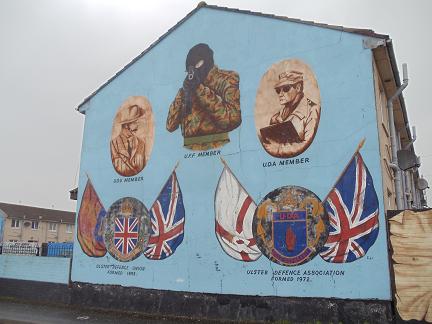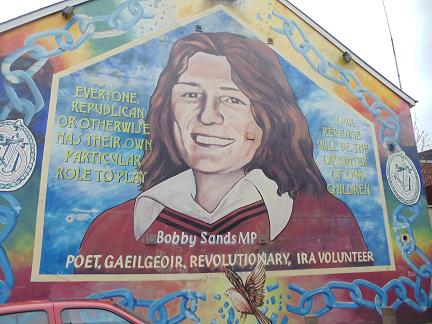The first thing the group did when we arrived in Belfast was we took a tour of the city. But, this wasn’t just any tour. We rode in old style black taxicab; the tour guides were our drivers, they knew absolutely everything there was to know about Northern Ireland and they made the experience so enjoyable (despite the cold rainy weather). They gave us their views of “The Troubles”. We drove to 5 different historical landmarks that lets tourists see some of the struggles the people in Belfast had to overcome. I found this political tour nothing short of eye opening to what these people have to deal with everyday. It’s sad how little most people outside of Ireland know about Northern Ireland and their uneven and dark past.
For those of you who aren’t familiar with the history of Northern Ireland, here is a very brief summary of what was going on: Due to the Anglo-Irish Treaty, Northern Ireland had been separated from Ireland and was now in Britain’s power in 1920. Northern Ireland was broken up into two communities, the Catholics and the Protestants. The Catholics were the minority and wanted to reunite with the Republic of Ireland. However, the Protestants we’re not going to stand for it, they wanted to stay loyal to Britain. Tension between the Protestants and the Catholics turned really ugly and Northern Ireland was falling apart. It wasn’t until the 1960’s when things started to get really violent because the Catholic’s civil rights were being violated. That’s when people started turning towards terrorists groups for safety and plans to attack the other group. The Peace Agreement wasn’t signed until 1998. The country is still picking itself up from the hostility and turmoil they endured but it’s a slow process. Due to all the bombings and murals that are in Belfast, it has become a great (if morbid) tourist attraction, which has allowed their economy to slowly pick up again. One of the tour guides said, “This is something we have to live with every day. We want to forgive and we’re all working on forgiving, but we must never forget.”

The majority of the sites we saw were murals painted for the Irish Republican Party, Ulster Freedom Fighters or for people who lost their lives during all the attacks. Our first stop on the tour was a residential neighborhood in Shankill where there were painted murals for the Loyalist party on the sides of the houses. The people that live in the houses don’t have any say about what goes into the murals. Our tour guide explained that some of the murals are beginning to be painted over with more neutral paintings that will attract tourists. The most memorable mural was the one of the sniper pointing a gun right out towards everyone. No matter where you stood while looking at the sniper, the gun looked like it was point right at you.
After the walk around the houses, the taxis took us to the Peace Wall. I think this was everyone’s favorite stop in Belfast. The Peace Wall (or Peace Line) was a wall put up in the 1960’s. The Peace Wall separates the Protestant and Catholic neighborhoods. It is 3 miles long and 25 feet high. The part that really moved me was that people from all over the world come and sign the Peace Wall, most of them write things about peace, forgiveness, love, hope and equality. In 2008 there was talk of taking the wall down but most of the residents want to keep it up. The tour guides explained to us that at 6:00 every night they lock the gates and no one can go through. It is crazy to think that people still live so segregated and have such negative feelings for someone that they need a physical wall to keep the peace. Needless to say, we all left our mark on the wall.

Our next stop was right on the Catholic side of the wall. It was a beautiful memorial known as the Clonard Martyrs Memorial Garden. This memorial was for those that died in that neighborhood and the IRA. They had paintings of the people that died in the attacks. The tour guides pointed out that the houses still the metal gates protecting them. They also passed around a bullet that the British used to attack the Catholics.

The guides then took us to Sinn Féin’s headquarters where the famous mural of Bobby Sands is. Bobby Sands was the leader of the 1981 hunger strike. He died after 66 days of the hunger strike at age 27. The hunger strike’s goal was to protest against the British government withdrawing from the Special Category Status for convicted parliamentary prisoners. Bobby Sands was an inspiration to many people and his death caught everyone’s attention and started a great stir of controversy.

Our last stop was the International Wall of Belfast. There are many different murals along the wall of people and originations. The painting that stood out to me was the depiction of Picasso’s painting of the Spanish Civil War. Every once in awhile the murals will change and they usually have to do with something political happening around the world. The purpose of the wall is to raise awareness of the difficulty that nations around the world are going through. Most of the murals that were up when we were there dealt with war being a crime, prisoners will not be forgotten and opposing racism. The paintings were beautiful and got the point across that there have been many bad times for different nations, and although we can’t forget what happened we need to learn from the past to make sure no one makes the same mistakes again.
After learning about many of these historical sites in my Northern Ireland course, it was great to actually see the real thing. It is one thing to read about them in the history books but taking a look at where it all happened put things in an entirely different perspective. Taking the tour was the highlight of my weekend and it allowed me to think a little bit deeper into what it must feel like living in Belfast every day and trying to put all the broken pieces back together.